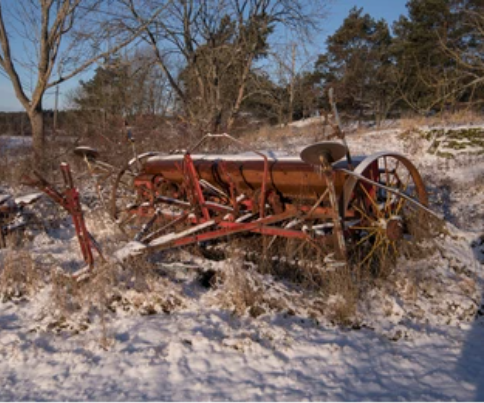The seed drill played a crucial role in the Industrial Revolution, transforming agriculture from a laborious, hand-based process to a more efficient and mechanized one. While its origins can be traced back to ancient Mesopotamia, it was the refinement and widespread adoption of the seed drill in the 18th century that truly revolutionized farming.
The Early Seed Drills:
-
Jethro Tull’s Invention (1701):English inventor Jethro Tull is often credited with inventing the modern seed drill in 1701. His design featured a hopper that dispensed seeds at regular intervals into furrows created by a plow, significantly reducing waste and improving seed germination.
-
Limited Adoption: Despite its advantages, Tull’s seed drill was initially met with resistance due to its high cost and complexity. It wasn’t until later in the century that advancements in metalworking and manufacturing made it more affordable and reliable.
Impact on the Industrial Revolution:
- Increased Efficiency: The seed drill dramatically improved planting efficiency. Instead of scattering seeds by hand, farmers could now plant rows of seeds at consistent depths and spacing, leading to higher yields and reduced labor costs.
- Improved Yields: Precise planting depth and spacing led to better germination and healthier plants, resulting in significantly higher crop yields.
- Crop Diversification: The improved efficiency and reliability of the seed drill encouraged farmers to experiment with new crops, fostering agricultural diversity.
- Land Use Optimization: The precise planting enabled by the seed drill allowed farmers to use land more effectively, reducing the need for fallow periods and increasing crop production.
- Shifting Labor: The adoption of the seed drill, along with other agricultural advancements, led to a shift from manual labor to mechanized farming. This freed up workers for other sectors, contributing to the growth of industry and urbanization.
Challenges and Criticisms
Legacy of the Seed Drill:
The seed drill’s impact extended far beyond the Industrial Revolution. It laid the foundation for modern agriculture, paving the way for further mechanization and technological advancements. Today, sophisticated seed drills equipped with GPS guidance and precision seeding technology continue to play a vital role in ensuring efficient and sustainable food production.
How did the seed drill impact the Industrial Revolution?
The seed drill’s impact on the Industrial Revolution wasn’t a simplistic cause-and-effect but rather a complex interplay of factors. While not directly causing the Revolution, it played a crucial role in creating the conditions that enabled its growth and prosperity, albeit with nuances and challenges:
Indirect Contributions:
- Increased Food Production: By drastically improving crop yields, the seed drill provided the necessary surplus food to sustain the growing urban populations of industrial centers. This reduced famine risks and allowed more people to move from rural areas to cities, fueling the industrial workforce.
- Labor Liberation: By reducing the labor needed for agriculture, the seed drill released farmworkers who could then be employed in factories and other industries. This provided essential manpower for industrial expansion.
- Economic Stimulation: Increased agricultural output meant more raw materials for industries and boosted overall economic activity. It also generated increased income for farmers, fueling spending and further economic growth.
- Market Expansion: With more abundant food and a larger disposable income, urban populations created a larger and more demanding market for industrial goods, further driving industrial production.
Nuances and Challenges:
- Timing: The seed drill was invented before the official start of the Industrial Revolution, so its influence was indirect and played a part in a broader agricultural revolution that laid the groundwork.
- Not the Sole Driver: The seed drill wasn’t the only factor influencing the Industrial Revolution. Advancements in textiles, energy, and transportation also played significant roles.
- Challenges to Adoption: Initial skepticism, affordability, and technical skill requirements limited the seed drill’s immediate impact.
- Potential Drawbacks: Overreliance on the seed drill and monoculture farming can lead to environmental concerns like soil degradation and loss of biodiversity. Additionally, labor displacement and affordability could contribute to social inequalities.
Overall, the seed drill’s impact on the Industrial Revolution was significant but multifaceted. It contributed to the necessary conditions for industrial growth through increased food production, labor availability, and economic stimulation. However, it’s important to acknowledge the nuances of timing, the interplay with other factors, and the potential downsides associated with its long-term use.
Conclusion
The seed drill, though invented before the Industrial Revolution, stands as a powerful symbol of its transformative spirit. This ingenious invention revolutionized agriculture, paving the way for increased food production, efficient labor allocation, and ultimately, the flourishing of industrial cities. While its impact wasn’t a simple cause-and-effect, the seed drill’s role in creating the conditions necessary for industrial growth is undeniable.
From freeing up laborers for factory jobs to feeding burgeoning urban populations, the seed drill’s influence rippled across various sectors, propelling the Industrial Revolution forward. However, it’s crucial to acknowledge the nuances of its impact. Challenges in adoption, potential environmental drawbacks, and concerns about social equity must be considered alongside its undeniable benefits.
As we move forward, the legacy of the seed drill inspires us to continue seeking innovative solutions for sustainable and equitable food production. By drawing on its ingenuity while addressing its limitations, we can strive for a future where technological advancements nourish not just industrial growth, but also the well-being of our planet and its people.
FAQs:
Q: How did the seed drill work?
Q: What were the limitations of early seed drills?
Early seed drills faced several challenges:
- High cost and complexity: They were expensive to purchase and maintain, often putting them out of reach for small farmers.
- Soil and terrain limitations: They weren’t well-suited for all soil types and terrains, particularly wet or uneven ground.
- Skill and knowledge requirements: Operating and maintaining them required skill and knowledge that not all farmers possessed.
These limitations slowed down the widespread adoption of the seed drill in the early years.
Q: What are the potential drawbacks of the seed drill?
While the seed drill has undoubtedly improved agricultural productivity, some potential drawbacks need to be considered:
- Monoculture and loss of diversity: Overreliance on the seed drill and monoculture farming practices can lead to a decline in soil health and biodiversity.
- Increased reliance on chemical inputs: High yields often come at the cost of increased dependence on chemical fertilizers and pesticides, raising concerns about environmental sustainability.
- Labor displacement: While the seed drill frees up labor, it can also lead to unemployment and social challenges in rural communities.
- Equity and affordability concerns: The high cost of modern drills and dependence on technology can exacerbate existing economic inequalities and limit access for marginalized communities.
Addressing these challenges and promoting sustainable agricultural practices are crucial to ensure the long-term benefits of the seed drill.
Q: What is the future of the seed drill?
Technological advancements continue to revolutionize the field of agriculture, and the seed drill is no exception. Here are some exciting developments in the future of seed drills:
- Precision agriculture: Utilizing sensors and data analysis, future drills will be able to adjust seeding rates and depths based on real-time soil conditions and plant needs.
- Robotics and automation: Autonomous seed drills, guided by GPS and AI, offer the potential for even greater efficiency and precision in planting.
- Sustainable materials and practices: Development of eco-friendly materials and seed treatments can minimize the environmental impact of seed drills.
These advancements hold promise for a future where the seed drill continues to play a crucial role in feeding the world while promoting sustainable and equitable agricultural practices





